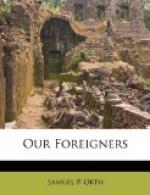There had been some trade between Ulster and the colonies, and a few Ulstermen had settled on the eastern shore of Maryland and in Virginia before the close of the seventeenth century. Between 1714 and 1720, fifty-four ships arrived in Boston with immigrants from Ireland. They were carefully scrutinized by the Puritan exclusionists. Cotton Mather wrote in his diary on August 7, 1718: “But what shall be done for the great number of people that are transporting themselves thither from ye North of Ireland?” And John Winthrop, speaking of twenty ministers and their congregations that were expected the same year, said, “I wish their coming so over do not prove fatall in the End.” They were not welcome, and had, evidently, no intention of burdening the towns. Most of them promptly moved on beyond the New England settlements.
The great mass of Scotch-Irish, however, came to Pennsylvania, and in such large numbers that James Logan, the Secretary of the Province, wrote to the Proprietors in 1729: “It looks as if Ireland is to send all its inhabitants hither, for last week not less than six ships arrived, and every day two or three arrive also."[1] These colonists did not remain in the towns but, true to their traditions, pushed on to the frontier. They found their way over the mountain trails into the western part of the colony; they pushed southward along the fertile plateaus that terrace the Blue Ridge Mountains and offer a natural highway to the South; into Virginia, where they possessed themselves of the beautiful Shenandoah Valley; into Maryland and the Carolinas; until the whole western frontier, from Georgia to New York and from Massachusetts to Maine, was the skirmish line of the Scotch-Irish taking possession of the wilderness.
The rebellions of the Pretenders in Scotland in 1715 and 1745 and the subsequent break-up of the clan system produced a considerable migration to the colonies from both the Highlands and the Lowlands. These new colonists settled largely in the Carolinas and in Maryland. The political prisoners, of whom there were many in consequence of the rebellions, were sold into service, usually for a term of fourteen years. In Pennsylvania the Welsh founded a number of settlements in the neighborhood of Philadelphia. There were Irish servants in all the colonies and in Maryland many Irish Catholics joined their fellow Catholics from England.




